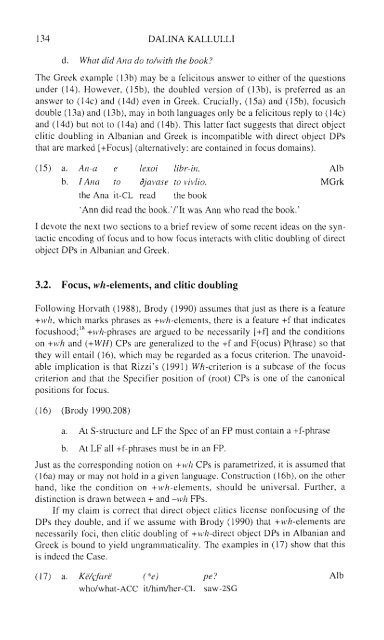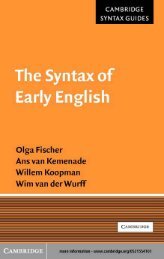Comparative Syntax of the Balkan Languages (Oxford ... - Cryptm.org
Comparative Syntax of the Balkan Languages (Oxford ... - Cryptm.org
Comparative Syntax of the Balkan Languages (Oxford ... - Cryptm.org
- No tags were found...
Create successful ePaper yourself
Turn your PDF publications into a flip-book with our unique Google optimized e-Paper software.
134 DALINA KALLULLId. What did Ana do to/with <strong>the</strong> book?The Greek example (13b) may be a felicitous answer to ei<strong>the</strong>r <strong>of</strong> <strong>the</strong> questionsunder (14). However, (15b), <strong>the</strong> doubled version <strong>of</strong> (13b), is preferred as ananswer to (14c) and (14d) even in Greek. Crucially, (15a) and (15b), focusichdouble (13a) and (13b), may in both languages only be a felicitous reply to (14c)and (14d) but not to (14a) and (14b). This latter fact suggests that direct objectclitic doubling in Albanian and Greek is incompatible with direct object DPsthat are marked [+Focus] (alternatively: are contained in focus domains).(15) a. An-a e lexoi libr-in. Albb. I Ana to djavase to vivlio. MGrk<strong>the</strong> Ana it-CL read <strong>the</strong> book'Ann did read <strong>the</strong> book.'/' It was Ann who read <strong>the</strong> book.'I devote <strong>the</strong> next two sections to a brief review <strong>of</strong> some recent ideas on <strong>the</strong> syntacticencoding <strong>of</strong> focus and to how focus interacts with clitic doubling <strong>of</strong> directobject DPs in Albanian and Greek.3.2. Focus, wh-elements, and clitic doublingFollowing Horvath (1988), Brody (1990) assumes that just as <strong>the</strong>re is a feature+ wh, which marks phrases as +wh-elements, <strong>the</strong>re is a feature +f that indicatesfocushood; +wh-phrases are argued to be necessarily [+f] and <strong>the</strong> conditionson +wh and (+WH) CPs are generalized to <strong>the</strong> +f and F(ocus) P(hrase) so that<strong>the</strong>y will entail (16), which may be regarded as a focus criterion. The unavoidableimplication is that Rizzi's (1991) Wft-criterion is a subcase <strong>of</strong> <strong>the</strong> focuscriterion and that <strong>the</strong> Specifier position <strong>of</strong> (root) CPs is one <strong>of</strong> <strong>the</strong> canonicalpositions for focus.(16) (Brody 1990.208)a. At S-structure and LF <strong>the</strong> Spec <strong>of</strong> an FP must contain a +f-phraseb. At LF all +f-phrases must be in an FP.Just as <strong>the</strong> corresponding notion on +wh CPs is parametrized, it is assumed that(16a) may or may not hold in a given language. Construction (16b), on <strong>the</strong> o<strong>the</strong>rhand, like <strong>the</strong> condition on +vv/i-elements, should be universal. Fur<strong>the</strong>r, adistinction is drawn between + and -wh FPs.If rny claim is correct that direct object clitics license nonfocusing <strong>of</strong> <strong>the</strong>DPs <strong>the</strong>y double, and if we assume with Brody (1990) that +wh-elements arenecessarily foci, <strong>the</strong>n clitic doubling <strong>of</strong> +wh-direct object DPs in Albanian andGreek is bound to yield ungrammaticality. The examples in (17) show that thisis indeed <strong>the</strong> Case.(17) a. Ke/ffare e
















